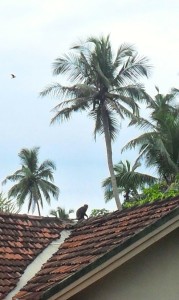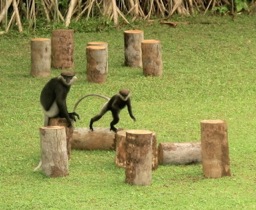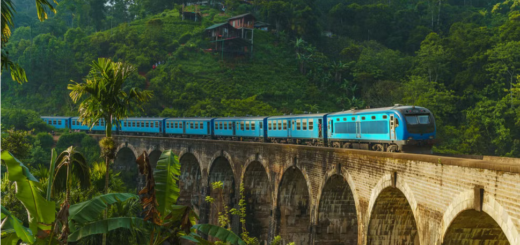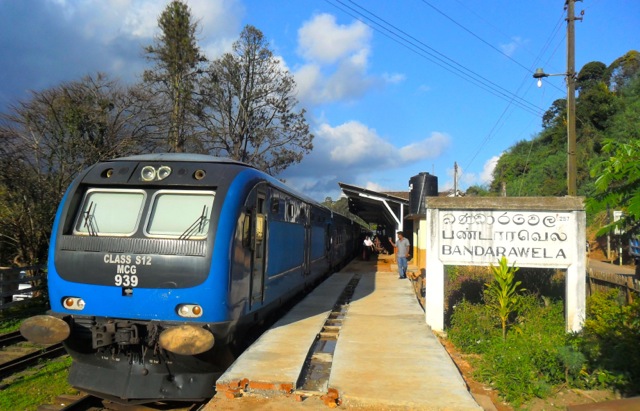SRI LANKA ROUNDABOUT (Number 4) – Endangered Neighbours
by · Published · Updated
A weekly look at Sri Lanka for Jetwing by Royston Ellis
Welcome to Jetwingers around the world to this week’s issue of my regular Jetwing newsletter about Sri Lanka.
Endangered Neighbours
 I was surprised to learn recently that I am living with an endangered species of neighbours whose survival is in serious jeopardy. When I hear a rumble on my roof I know that the jolly creatures that often picnic in my garden are taking a short cut cross the tiles to get to the trees at the other side of my house. That worries me as they swing along on the cable supplying electricity; if it snaps, we’ll have no light and the simian acrobat might get electrocuted.
I was surprised to learn recently that I am living with an endangered species of neighbours whose survival is in serious jeopardy. When I hear a rumble on my roof I know that the jolly creatures that often picnic in my garden are taking a short cut cross the tiles to get to the trees at the other side of my house. That worries me as they swing along on the cable supplying electricity; if it snaps, we’ll have no light and the simian acrobat might get electrocuted.
My neighbours, the purple-faced langurs, or Kalu Wandura as they are known in Sinhala (Semnopithecus vetulus), are endangered not just from my electric wiring but because of their shrinking habitat. This black and grey whiskered monkey is endemic to Sri Lanka and found nowhere else in the world. The International Union for Conservation of Nature (ICUN) has officially identified it as endangered and, given its unique biological status, people like me living in its territory, have a duty to the world to make sure it survives.
There are actually four subspecies of Kalu Wandura and the troop that lives in the trees around my house on the west coast, the Western Purple Faced Langur, is listed among the 25 most endangered primates in the world. It’s threatened with extinction because of the rapid urbanisation along the coast. When the creatures’ territory is taken over by new buildings and trees cut down, these animals have nowhere to find food and shelter.
 The Kalu Wandura depends on trees for its survival; it lives in family groups and eats, sleeps, travels, raises its young, and makes love in the treetops. Leaves are its staple diet. Its early morning burst of feeding is followed by a period of rest to allow it to digest its leafy breakfast. Three or four bouts of feeding, when it seems to be raining langurs as they leap from tree to tree, alternate with rest periods throughout the day.
The Kalu Wandura depends on trees for its survival; it lives in family groups and eats, sleeps, travels, raises its young, and makes love in the treetops. Leaves are its staple diet. Its early morning burst of feeding is followed by a period of rest to allow it to digest its leafy breakfast. Three or four bouts of feeding, when it seems to be raining langurs as they leap from tree to tree, alternate with rest periods throughout the day.
There are many similarities between the Kalu Wandura and humans as, like human families, the Kalu Wandura family has exclusive rights to its home land, defined by boundaries. A section of the territory is the bedroom for sleeping at night while my garden, where the troop likes to frolic and picnic on coconut palm trunks on the lawn, seems to be the family dining room.
Unfortunately, my human neighbours don’t care about threats to the langurs’ existence. They light crackers to deter them from pulling up roof tiles and eating bananas and mangoes on the trees, and get angry when these engaging, harmless monkeys appear, nonchalantly bouncing from branch to branch with amazing grace and accuracy. I don’t worry. Instead I leave bananas on the picnic tables and hope that by not harassing them, I can contribute to preventing the extinction of this friendly and fascinating, neighbourly troop of Kalu Wanduras.
Royston Ellis (www.roystonellis.com) is a British author resident in Sri Lanka since 1980.




